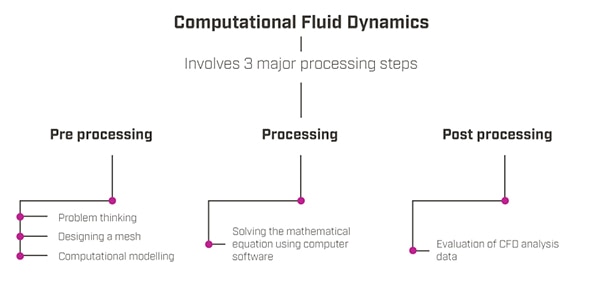了解电气工程中的计算流体力学
2025-01-03
在电气工程领域,管理热传递和冷却系统对于确保可靠性和效率至关重要。猜测和愿望是不切实际的,而反复试验的方法成本高、效率低。通过将热量概念化为流体,工程师可以实现精确而逼真的建模方法。计算流体力学 (CFD) 已成为分析和解决热管理难题的重要工具,能够让团队在投资实际资源之前探索解决方案并降低风险。本文将对 CFD 提供一个整体性概览,包括其工作原理及其在电子设计中的优势。
CFD - 基础知识
CFD 使用数值算法来求解控制流体力学和热传递的复杂非线性偏微分方程。这些计算创建了详细的三维模型,准确地反映了物理系统的空间和时间动态。这种方法为工程师带来了现实洞察力,而无需承担高昂的实验装置成本。
CFD 通过模拟流体和固体之间的相互作用并评估周围流体内的对流行为,改变了热分析。该技术将传导、对流和辐射这三种主要热传递方式融入到流体流动模拟中。这样就能进行全面的热行为评估,这在电气工程应用中是不可或缺的。
大多数 CFD 软件都是为通用应用而设计的,用于模拟热传递、气流、相变等现象。不过,目前已有专门的 CFD 工具,专门用于热传递,尤其是电子设备内的热传递,在这些设备中,热行为的精确建模对于确保性能和可靠性至关重要。与通用 CFD 工具不同,这些小众解决方案通过为特定应用量身定制功能来简化流程。例如,专用软件可以对集成电路封装、电路板、散热器、热导管和风扇进行建模。其主要功能包括根据计算出的系统阻力确定冷却风扇的工作点,从而确保足够的气流,同时避免不必要的功耗。其他 CFD 热分析数据可包括:
- 气流场和模式:了解电子元件周围的气流行为
- 热流率:量化表面热传递强度
- 热点识别:检测局部过热区域
- 温度分布:绘制整个系统的热梯度图
- 传热速率:评估冷却机构的传热效率
这些数据能够让工程师优化设计以实现有效散热、加强冷却策略并防止热故障。这些洞察力对于保持系统可靠性和延长电气设备的使用寿命至关重要。
 图 1:CFD 分析示例。(图片来源:Same Sky)
图 1:CFD 分析示例。(图片来源:Same Sky)
CFD - 如何运作?
计算流体力学依赖源自物理学的三个核心原理:质量守恒、动量守恒和能量守恒。这些原理通过纳维•斯托克斯方程在数学上得以表达。当 CFD 模型根据这些方程进行正确配置并收敛到一个解决方案时,其本质上就满足了基本物理定律,从而确保了结果的可靠性。
标准的 CFD 分析通常包括三个主要过程。然而,采用包括初步和后处理活动在内的额外步骤可以大大提高分析的全面性和准确性。
 图 2:CFD 涉及三个主要处理步骤。(图片来源:Same Sky)
图 2:CFD 涉及三个主要处理步骤。(图片来源:Same Sky)
在开始 CFD 分析之前,首先必须将问题表述为偏微分方程系统。这一基础阶段至关重要,因为它定义了描述所研究物理现象的控制方程——通常基于纳维•斯托克斯方程。这一步骤可确保数学模型准确地反映问题的物理行为,可作为 CFD 分析的着手之处。
- 预处理阶段:在预处理阶段,CFD 软件将偏微分方程转换为离散代数方程。这一阶段的关键活动是生成网格,将计算域划分为结构化或非结构化元素(如三角形、四边形或四面体)。
在流场的关键区域,特别是靠近边界或高梯度区域,细化网格元素的尺寸,可确保更准确地反映物理现象。这一步骤直接影响模拟结果的质量和精度。
- 处理阶段: 在求解阶段,CFD 模拟软件对预处理阶段生成的代数方程进行数值求解。模拟过程在很大程度上受多个因素的影响,这些因素决定了计算时间和精度,其中包括:
- 计算机硬件能力,如处理器速度和内存
- 优化计算速度的矢量化和并行化技术
- 数据结构,确保高效的数据处理
- 确定收敛和模拟完成的停止标准
- 网格大小和质量,以及瞬态模拟的时间分辨率
- 影响代码效率和执行的编程语言
工程师还可以调整各种模拟参数,针对具体应用优化分析。
- 后处理阶段:后处理阶段的重点是分析和解释模拟结果。从 CFD 模拟中提取的数据可通过图像、图表和表格实现可视化,从而深入了解各种参数。根据从这些参数发现的问题,工程师可确定是否需要进一步测试、优化或重新设计。无论是验证设计、提高系统性能还是排除故障,有效的后处理对于结果沟通和可行步骤的确定都至关重要。
解决热点问题
与物理实验相比,CFD 模拟可提供高精度和有价值的见解,特别是对于检测热点具有挑战性的复杂流动系统。热点是温度明显高于周围环境的局部区域。如果不加以解决,这些热点可能会随着时间的推移导致热量积聚,造成严重后果,如系统故障、失效或对产品造成不可逆转的损坏。这些问题会影响电子设备的使用寿命,并可能危及用户安全。
通过 CFD 热模拟,工程师可以准确预测并直观显示产品设计中的热分布。这种能力可以及早识别潜在的热点。有了这些信息,就可以有针对性地修改设计,如增强散热机构、优化材料性能或重新配置气流路径,以防止热量过度积聚。因此,系统对热应力的承受能力更强,从而降低了损坏的可能性,并延长了系统工作寿命。
利用 CFD 节省成本和时间
工程师们一直致力于开发性能更好的电子产品,但能否进行大规模生产往往取决于严格的实际测试结果。现代电子产品的设计过程越来越复杂,产品越来越紧凑,即使开发一个原型也需要投入大量的时间和资源。原型制作完成后,要进行热应变测试,以评估其耐用性、物理性能和实际性能。只有通过这些测试的原型才能进入批量生产,而失败则会导致初始投资的全部损失。
CFD 能够在电子产品的虚拟模型上模拟真实世界的条件,为实际测试提供了一个强大的替代方案。通过 CFD,工程师可以对其设计进行热传递分析,找出热问题并改进模型,而无需物理原型。与传统的物理测试相比,这种迭代模拟过程可提供精确的结果,包括详细的流动模式和热分布可视化效果,因此可以更深入地了解复杂的流动和热传递系统。
结语
通过利用 CFD 模拟,工程师可以有效地优化产品设计,减少了物理原型制作相关的时间和成本。这种方法最大限度降低了失败风险,加快了开发进程,并确保最终产品投入大规模生产前即已进行了性能和可靠性提升。如果您对在何处以及如何开始使用 CFD 有任何疑问,Same Sky 的热设计服务和一系列热管理组件可以提供帮助。
免责声明:各个作者和/或论坛参与者在本网站发表的观点、看法和意见不代表 DigiKey 的观点、看法和意见,也不代表 DigiKey 官方政策。








